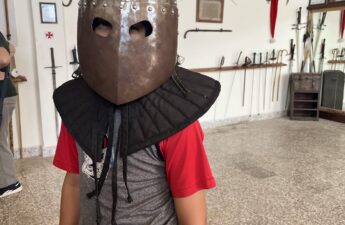Prague was the next stop on our European adventure. It is the capital of the Czech Republic and is rich in history. It was home to many Holy Roman Emperors and played an important role in the Habsburg monarchy and the Astro-Hungarian Empire.

Our Airbnb is located close to the old town. It is in an old building with twenty-foot-tall ceilings. The bed Lucas and Henry slept in is in the main room with the kitchen and couch. We are used to that. The place is cozy, and our host was helpful with tips for exploring the city. We enjoyed our stay there.

We spent our few days in Prague walking around the old city and seeing historical sights, including Prague Castle, Charles Bridge, Old Town Square, and Prague’s astronomical clock. We also spent a lot of time wandering through the various Christmas markets. They seem to be on every corner with vendors selling mulled wine, hot chocolate, sweet treats, and crafts. It is magical to see Prague lit up at night during the holidays.



It was freezing while we were there. The high temperatures were in the low 30s during the day. We logged over 12,000 steps a day. One day we walked two miles to the Strahov Monastery (founded in 1138). The long walk deserved some beer and hot chocolate at the Strahov Brewery. Master brewers have been brewing beer there for over 600 years. Lucas and Henry even ate ice cream despite the frigid temperatures.


We had to do some things indoors because it was too cold to spend all day walking around. We went to the Lego Museum and learned about the history of Legos. Lucas and Henry liked the museum, but Michael was in heaven. The museum has over 3,000 sets, and he saw a lot of the Lego sets he still has.

We also went to the Illusion Art Museum. It is billed as Prague’s first museum dedicated to illusion and trick art. We visited a similar museum a few years ago in Playa del Carmen, Mexico. We had fun taking pictures and being stunned by the illusions.








On our coldest day in Prague, we signed up for a communism and nuclear bunker tour. This is a fascinating tour of the communist history of the Czech Republic. Lucas and Henry were amazed that it all happened not so long ago. Half of the 3-hour tour is a walking tour through the Old Town. The tour ends with a trip to a nuclear bunker outside the city.




Prague Castle is a UNESCO monument founded around 880. The Guinness Book of World Records lists Prague Castle as the largest coherent castle complex in the world. We were there to witness the changing of the guards, which takes place every day at noon. It is a fanfare with a band and soldiers.

Our ticket included visits to St. Vitus Cathedral, Old Royal Palace, St. George’s Basilica, and Golden Lane. St. Vitus Cathedral is a Roman Catholic cathedral in Prague and the seat of the Archbishop of Prague. The beautiful gothic architecture is jaw-dropping when the cathedral first comes into view. Old Royal Palace is part of Prague Castle. When you walk in, the first room is Vladislav Hall, the room used for inaugurations. St. George’s Basilica is the oldest surviving church (consecrated in 921) within Prague Castle.


Golden Lane is a street within Prague Castle that up until 1950, housed people. Originally, it was built in the 1500s to house castle guards, and later became home to seamstresses, writers, and goldsmiths (where the name comes from). Lucas and Henry’s favorite part of touring Prague Castle was the museum of medieval armory.

We couldn’t leave Prague without having some Pilsner from a tank. Crisp, cool and delicious.





